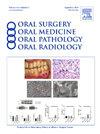Phosphaturic mesenchymal tumor of the mandible presenting with an epithelial component in a patient with kidney dysfunction and tumor-induced osteomalacia
IF 1.9
3区 医学
Q2 DENTISTRY, ORAL SURGERY & MEDICINE
Oral Surgery Oral Medicine Oral Pathology Oral Radiology
Pub Date : 2025-07-21
DOI:10.1016/j.oooo.2025.04.075
引用次数: 0
Abstract
Phosphaturic mesenchymal tumor (PMT) is a benign neoplasm that causes tumor-induced osteomalacia via secretion of fibroblast growth factor-23 (FGF-23). The FGF-23 secreted by osteocytes acts on the renal tubules causing phosphaturia. Patients exhibit hypophosphatemia and bone demineralization and endure significant loss of function and pain as a result. The patients have abnormal lab values before tumor resection such as an elevation in FGF-23 and serum alkaline phosphatase, low phosphorus, and low or unusually normal 1-25 dihydroxyvitamin D. However, in some cases, osteomalacia may not be apparent at the time of biopsy. Histologically, most PMTs present as nonspecific masses with difficult to discern features. The tumor contains a rich vascular supply which is often hemangiopericytoma-like and features a “grungy” calcifying matrix. Fibrohistiocytic spindled cells proliferate and can produce areas reminiscent of giant cell tumors of bone. Histological subtypes have been identified but appear to be minor morphologic variants. The diagnosis is challenging, and it can take years due to symptomatology, tumor localization, and diagnostic challenges. It is rarely reported in the head and neck, and when it involves the jaws, it can contain a variable epithelial component which complicates the diagnostic process. Here we report a case of a phosphaturic mesenchymal tumor presenting in the mandible with an epithelial component. We discuss the diagnostic challenges and the clinical outcome.
在肾功能不全和肿瘤诱发的骨软化症患者中,下颌骨磷化间充质肿瘤表现为上皮成分
磷化间充质瘤(PMT)是一种良性肿瘤,通过分泌成纤维细胞生长因子-23 (FGF-23)引起肿瘤诱导的骨软化。骨细胞分泌的FGF-23作用于肾小管,引起磷酸尿。患者表现为低磷血症和骨脱矿,并因此遭受严重的功能丧失和疼痛。患者在肿瘤切除前有异常的实验室值,如FGF-23和血清碱性磷酸酶升高,低磷,1-25二羟基维生素d低或异常正常。然而,在某些情况下,骨软化在活检时可能不明显。组织学上,大多数pmt表现为难以辨别特征的非特异性肿块。肿瘤含有丰富的血管供应,常呈血管外皮细胞瘤样,呈“脏乱”钙化基质。纤维组织细胞纺锤体细胞增生,可产生类似骨巨细胞瘤的区域。组织学亚型已经确定,但似乎是较小的形态变异。诊断具有挑战性,由于症状学、肿瘤定位和诊断挑战,可能需要数年时间。它很少发生在头颈部,当它累及颌骨时,它可能包含一个可变的上皮成分,这使诊断过程复杂化。在这里我们报告一个病例的磷化间充质肿瘤呈现在下颌骨上皮成分。我们讨论诊断的挑战和临床结果。
本文章由计算机程序翻译,如有差异,请以英文原文为准。
求助全文
约1分钟内获得全文
求助全文
来源期刊

Oral Surgery Oral Medicine Oral Pathology Oral Radiology
DENTISTRY, ORAL SURGERY & MEDICINE-
CiteScore
3.80
自引率
6.90%
发文量
1217
审稿时长
2-4 weeks
期刊介绍:
Oral Surgery, Oral Medicine, Oral Pathology and Oral Radiology is required reading for anyone in the fields of oral surgery, oral medicine, oral pathology, oral radiology or advanced general practice dentistry. It is the only major dental journal that provides a practical and complete overview of the medical and surgical techniques of dental practice in four areas. Topics covered include such current issues as dental implants, treatment of HIV-infected patients, and evaluation and treatment of TMJ disorders. The official publication for nine societies, the Journal is recommended for initial purchase in the Brandon Hill study, Selected List of Books and Journals for the Small Medical Library.
 求助内容:
求助内容: 应助结果提醒方式:
应助结果提醒方式:


